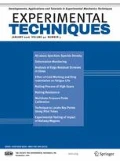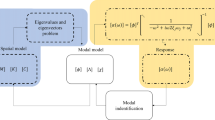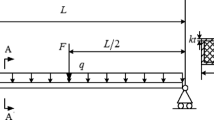Abstract
Real-time hybrid substructuring (RTHS) has previously been shown to be an effective tool to quantify the effect of parametric uncertainties on the response of a structural system. Proposed and implemented in this paper is a method that combines RTHS, Principal Component Analysis, and Kriging to metamodel the frequency response functions of a structure. The proposed method can be used to account for parametric variation in both the numerical and physical substructures. This approach is demonstrated using a series of bench-scale RTHS tests of a magnetorheological (MR) fluid damper used to control a 2 degree-of-freedom mass-spring system. The numerical system spring stiffnesses and the physical current supplied to the MR damper are each treated as uniformly distributed random variables. The RTHS test data is used to train computationally fast metamodels, which can then be used to conduct Monte Carlo simulations to determine distributions of the system response. The proposed methodology is shown to be both efficient and accurate.



























Similar content being viewed by others
References
Blakeborough A, Williams MS, Darby AP, Williams DM (2001) The development of real–time substructure testing. Philos Trans Royal Soc A 359(1786):1869–1891
Mahin SA, Shing PSB (1985) Pseudodynamic method for seismic testing. J Struct Eng 111(7):1482–1503
Mahin SA, Shing PSB, Thewalt CR, Hanson RD (1989) Pseudodynamic test method - current status and future directions. J Struct Eng 115(8):2113–2128
Nakashima M, Kato H, Takaoka E (1992) Development of real-time pseudo dynamic testing. Earthq Eng Struct Dyn 21(1):79–92
Christenson R, Lin YZ, Emmons A, Bass B (2008) Large-scale experimental verification of semiactive control through real-time hybrid simulation. J Struct Eng 134(4):522–534
Shao X, Reinhorn AM, Sivaselvan MV (2010) Real-time hybrid simulation using shake tables and dynamic actuators. J Struct Eng 137(7):748–760
Jiang Z, Kim SJ, Plude S, Christenson R (2013) Real-time hybrid simulation of a complex bridge model with MR dampers using the convolution integral method. Smart Mater Struct 22(10):105008
Chae Y, Ricles JM, Sause R (2013) Large-scale experimental studies of structural control algorithms for structures with magnetorheological dampers using real-time hybrid simulation. J Struct Eng 139(7):1215–1226
Chae Y, Ricles JM, Sause R (2014) Large-scale real-time hybrid simulation of a three-story steel frame building with magneto-rheological dampers. Earthq Eng Struct Dyn 43(13):1915–1933
Friedman A, Dyke SJ, Phillips B, Ahn R, Dong B, Chae Y et al (2014) Large-scale real-time hybrid simulation for evaluation of advanced damping system performance. J Struct Eng 141(6):04014150
Botelho RM, Christenson RE (2014) Mathematical framework for real-time hybrid substructuring of marine structural systems. In: Dynamics of Civil Structures, Volume 4: Proceedings of the 32nd IMAC, A Conference and Exposition on Structural Dynamics, Orlando, Florida, USA. Springer, pp 175-185
Metropolis N, Ulam S (1949) The Monte Carlo method. J Am Stat Assoc 44(247):335–341
Abbiati G, Marelli S, Bursi OS, Sudret B, Stojadinovic B (2015) Uncertainty propagation and global sensitivity analysis in hybrid simulation using polynomial chaos expansion. In Proc. 4th Int. Conf. Soft Comput. Tech. Civil, Struct. Environ. Eng. Prag (Czech Republic)
Abbiati G, Schöbi R, Sudret B, Stojadinovic B (2017) Structural reliability analysis using deterministic hybrid simulations and adaptive kriging metamodeling. In: Proceedings of the 16th World Conference on Earthquake (16WCEE), Santiago, Chile, (paper no. 595)
Chen C, Xu W, Guo T, Chen K (2017) Analysis of actuator delay and its effect on uncertainty quantification for real-time hybrid simulation. Earthq Eng Eng Vib 16(4):713–725
Xiu D, Karniadakis GE (2002) The wiener--Askey polynomial chaos for stochastic differential equations. SIAM J Sci Comput 24(2):619–644
Santner TJ, Williams BJ, Notz WI (2003) The design and analysis of Computer experiments. Springer-Verlag, New York
Faravelli L (1989) Response-surface approach for reliability analysis. J Eng Mech 115(12):2763–2781
Echard B, Gayton N, Lemaire M (2011) AK-MCS: an active learning reliability method combining Kriging and Monte Carlo simulation. Struct Saf 33(2):145–154
Ligeikis C, Christenson R (2020) Assessing structural reliability using real-time hybrid substructuring. Int J Lifecycle Performance 4(1-3):158–183Engineering
Chatterjee T, Chakraborty S, Chowdhury R (2016) A bi-level approximation tool for the computation of FRFs in stochastic dynamic systems. Mech Syst Signal Process 70:484–505
DiazDelaO FA, Adhikari S, Flores ES, Friswell MI (2013) Stochastic structural dynamic analysis using Bayesian emulators. Comput Struct 120:24–32
Fricker TE, Oakley JE, Sims ND, Worden K (2011) Probabilistic uncertainty analysis of an FRF of a structure using a Gaussian process emulator. Mech Syst Signal Process 25(8):2962–2975
Jacquelin E, Adhikari S, Sinou JJ, Friswell MI (2014) Polynomial chaos expansion and steady-state response of a class of random dynamical systems. J Eng Mech 141(4):04014145
Jacquelin E, Adhikari S, Sinou JJ, Friswell MI (2015) Polynomial chaos expansion in structural dynamics: accelerating the convergence of the first two statistical moment sequences. J Sound Vib 356:144–154
Lu J, Zhan Z, Apley DW, Chen W (2019) Uncertainty propagation of frequency response functions using a multi-output Gaussian process model. Comput Struct 217:1–17
Manan A, Cooper JE (2010) Prediction of uncertain frequency response function bounds using polynomial chaos expansion. J Sound Vib 329(16):3348–3358
Pichler L, Pradlwarter HJ, Schuëller GI (2009) A mode-based meta-model for the frequency response functions of uncertain structural systems. Comput Struct 87(5–6):332–341
Jolliffe I (1986) Principal component analysis. Springer-Verlag, New York
Yaghoubi V, Marelli S, Sudret B, Abrahamsson T (2017) Sparse polynomial chaos expansions of frequency response functions using stochastic frequency transformation. Probabilistic Eng Mech 48:39–58
Jia G, Taflanidis AA (2013) Kriging metamodeling for approximation of high-dimensional wave and surge responses in real-time storm/hurricane risk assessment. Comput Methods Appl Mech Eng 261:24–38
Spencer BF Jr, Dyke SJ, Sain MK, Carlson J (1997) Phenomenological model for magnetorheological dampers. J Eng Mech 123(3):230–238
Sobol IYM (1967) On the distribution of points in a cube and the approximate evaluation of integrals. Zhurnal Vychislitel'noi Matematiki i Matematicheskoi Fiziki, 7(4), 784-802; U.S.S.R. Comput. Math. Math. Phys., 7(4), 86–112
McKay MD, Beckman RJ, Conover WJ (1979) Comparison of three methods for selecting values of input variables in the analysis of output from a computer code. Technometrics 21(2):239–245
MATLAB Release 2017a [Computer software]. (2017). Natick: The Mathworks, Inc.
Welch P (1967) The use of fast Fourier transform for the estimation of power spectra: a method based on time averaging over short, modified periodograms. IEEE Trans Audio Electroacoust 15(2):70–73
Bendat JS, Piersol AG (2010) Random data: analysis and measurement procedures. Wiley, Hoboken
Krige DG (1951) A statistical approach to some basic mine valuation problems on the Witwatersrand. J South Afr Inst Min Metall 52(6):119–139
Matheron G (1963) Principles of geostatistics. Econ Geol 58(8):1246–1266
Sacks J, Welch WJ, Mitchell TJ, Wynn HP (1989) Design and analysis of computer experiments. Stat Sci:409–423
Friedman J, Hastie T, Tibshirani R (2001) The elements of statistical learning. Springer Series in Statistics, New York
Bachoc F (2013) Cross validation and maximum likelihood estimations of hyper-parameters of Gaussian processes with model misspecification. Comput Stat Data Anal 66:55–69
Blatman G, Sudret B (2013) Sparse polynomial chaos expansions of vector-valued response quantities. In: Proc. 11th Int. Conf. Struct. Safety and Reliability (ICOSSAR’2013)
Tipping ME, Bishop CM (1999) Probabilistic principal component analysis. J R Stat Soc Series B (Stat Methodol) 61(3):611–622
Marelli S, Sudret B (2014) UQLab: a framework for uncertainty quantification in Matlab. In: Vulnerability, Uncertainty, and Risk: Quantification, Mitigation, and Management, pp 2554-2563
Lataniotis C, Wicaksono D, Marelli S, Sudret B (2019) UQLab user manual – Kriging (Gaussian process modeling), report #UQLab-V1.3-105, chair of risk, safety and uncertainty quantification, ETH Zurich, Switzerland
Lord Corporation (2009) Lord technical data RD-8040-1 and RD-8041-1 dampers. [data sheet] Retrieved from http://www.lordmrstore.com/lord-mr-products/rd-8041-1-mr-damper-long-stroke
Simulink Release 2017a [Computer software]. (2017). Natick: The Mathworks, Inc.
Horiuchi T, Nakagawa M, Sugano M, Konno T (1996) Development of a real-time hybrid experimental system with actuator delay compensation. In: Proceedings of the 11th World Conference on Earthquake Engineering, Acapulco, Mexico, (paper no. 660)
Ahmadizadeh M, Mosqueda G, Reinhorn AM (2008) Compensation of actuator delay and dynamics for real-time hybrid structural simulation. Earthq Eng Struct Dyn 37(1):21–42
Carrion JE, Spencer Jr BF (2007) Model-based strategies for real-time hybrid testing. NSEL report series, report no. NSEL-006, Newmark structural Engineering Laboratory, University of Illinois at Urbana-Champaign
Chen C, Ricles JM (2009) Analysis of actuator delay compensation methods for real-time testing. Eng Struct 31(11):2643–2655
Horiuchi T, Inoue M, Konno T, Namita Y (1999) Real-time hybrid experimental system with actuator delay compensation and its application to a piping system with energy absorber. Earthq Eng Struct Dyn 28(10):1121–1141
Phillips BM, Spencer BF Jr (2012) Model-based feedforward-feedback actuator control for real-time hybrid simulation. J Struct Eng 139(7):1205–1214
Kwok NM, Ha QP, Nguyen TH, Li J, Samali B (2006) A novel hysteretic model for magnetorheological fluid dampers and parameter identification using particle swarm optimization. Sensors Actuators A Phys 132(2):441–451
Jiang Z, Christenson RE (2012) A fully dynamic magneto-rheological fluid damper model. Smart Mater Struct 21(6):065002
Ligeikis C (2019) Exploring uncertainty in real-time hybrid substructuring. (Master’s Thesis, University of Connecticut)
Adhikari S, Pascual B (2016) The ‘damping effect’ in the dynamic response of stochastic oscillators. Probabilistic Engineering Mechanics 44:2–17
Acknowledgements
This work was supported by the Office of Naval Research under project DOD/NAVY/ONR, Award No. N00014-11-1-0260, Program Directors Deborah Nalchajian and Gregory Orris.
Author information
Authors and Affiliations
Corresponding author
Additional information
Publisher’s Note
Springer Nature remains neutral with regard to jurisdictional claims in published maps and institutional affiliations.
Rights and permissions
About this article
Cite this article
Ligeikis, C., Christenson, R. Identifying Stochastic Frequency Response Functions Using Real-Time Hybrid Substructuring, Principal Component Analysis, and Kriging Metamodeling. Exp Tech 44, 763–786 (2020). https://doi.org/10.1007/s40799-020-00389-2
Received:
Accepted:
Published:
Issue Date:
DOI: https://doi.org/10.1007/s40799-020-00389-2




